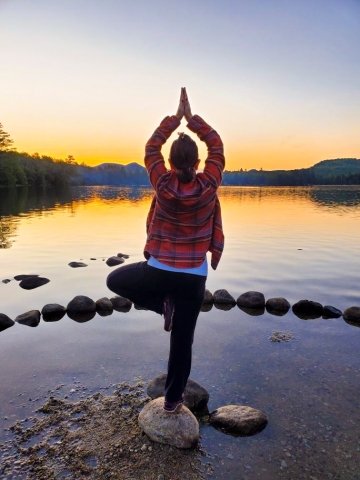The Healing Power of Nature: Expert Tips for Practicing Yoga Outdoors

In this blog, we discuss tips for bringing your yoga practice outdoors.
The practice of yoga has evolved and adapted throughout the centuries, constantly finding new ways to connect individuals with their inner selves and the world around them. While yoga today is commonly associated with studio classes and serene meditation spaces, its roots trace back to ancient times when practitioners would often embrace the great outdoors.

We spoke with Christine Badalamenti Smith, yoga therapist and founder of OGGI BE Yoga Therapy & Rewilding in South Burlington, about her personal and professional experience with outdoor yoga.
In our modern, fast-paced lives, it's easy to become disconnected from the earth beneath our feet. “Practicing yoga outside reminds me that I am connected in more ways than my mind can comprehend to all that surrounds me, and that all that surrounds me is connected inextricably to what is within,” shares Christine.
Health Benefits
In addition to connecting us to nature, wandering outside will introduce the following to your practice:
- Vitamin D: The "sunshine vitamin” supports healthy bones, improves mood, and reduces the risk of certain chronic diseases.
- Fresh air: The abundance of oxygen in natural settings helps to cleanse and rejuvenate the respiratory system, leading to increased lung capacity and improved oxygenation of the blood.
- Enhanced physical challenges: The variability of outdoor conditions can deepen the physical benefits of yoga, helping to tone muscles, increase joint stability, and enhance overall physical fitness.
Preparation
As with any outdoor activity, it’s important to be prepared for certain elements such as unfavorable weather. Packing essentials such as sunscreen, bug spray, extra layers, and water can help ensure an enjoyable practice.
“If it’s just an uptick in wind or a little light rain, then you can use that as a way to explore your edges and boundaries and ability to be with what is,” says Christine. “You can stay and practice while it is working for you and when it isn’t any longer, you have learned something about yourself that day.”
Your outdoor yoga practice doesn’t have to end when it gets a bit colder. Plenty of yogis will venture outdoors, even in the winter, to practice “Snowga.” You may need to bundle up with a few more layers, but it may just be worth it. Imagine the tranquility freshly fallen snow could offer!
Picking a place

Can you name a place that brings you peace? That may be a good place to start. It can be a challenge to find a place that works perfectly on your first try. Christine suggests trying different locations and taking notice how different environments affect you. “It feels very different to practice in a wide-open field, versus within the interior of a heavily wooded area, or near a large body of water,” says Christine. “You can be curious about who you become and how you interact with each of these environments.”
When you find a place you like, you might consider establishing a regular practice where you can start to build a relationship with your surroundings. Or you might choose to continue to switch it up each time. The key is to do what feels right to you.
Additional Expert Tips
Christine’s mission is to help people feel at home, alive, and powerful in their bodies and in the natural world. She offered the following tips for whenever you arrive at your outdoor practice destination:
- Do the yoga you know how to do. Use yoga as a tool for understanding what works for you in all sorts of situations. If you know certain things help quiet your mind and open your senses so that you can feel more connected to your whole being and to your surroundings, then those are the expressions you should try when outdoors.
- Take in your surroundings. What do you see? A mountain? What shape makes you feel like a mountain? What would the opposite of that experience be? How is that mountain’s essence reflected in the essence of you? Try things on!
- Close your eyes and listen for different near and far sounds. Use a technique like this as a meditation at some point in your practice and feel the impact it has on your body and your nervous system and your experience overall.
- Never put yourself in a dangerous situation. Ask yourself the following questions when adjusting to the outdoors: “Am I safe?” and “Am I capable and prepared to handle this?” Yoga is a practice of knowing the self and it will not benefit your practice, your experience, or others to not be earnest about these questions.
Blue Cross Vermont members receive a 10 percent discount on eligible OGGI BE services, including individual and couples’ yoga therapy sessions and packages, group series, and rewilding experiences. So, roll out your mat, breathe in the mountain air, and let nature be your ultimate guide in your next yoga practice.



